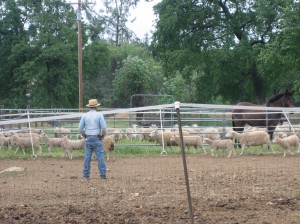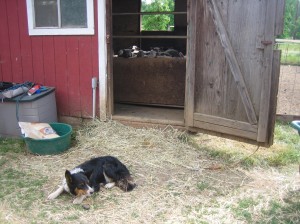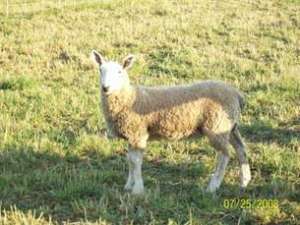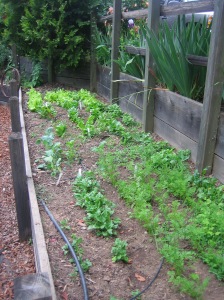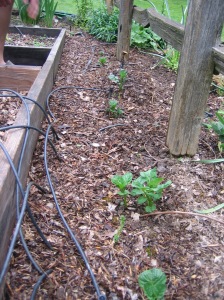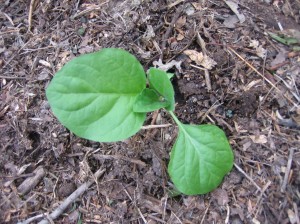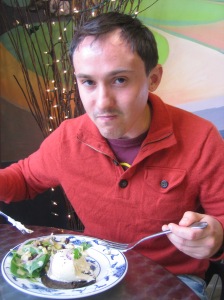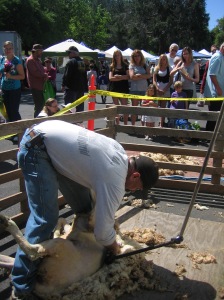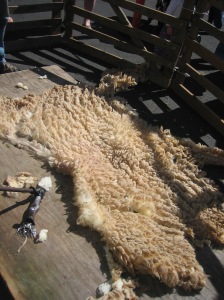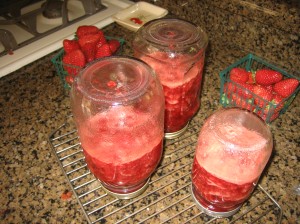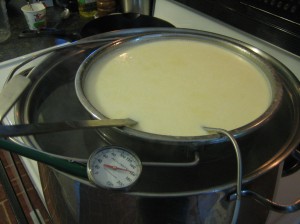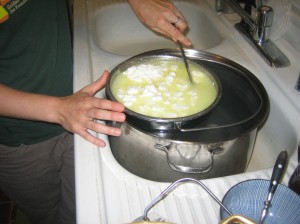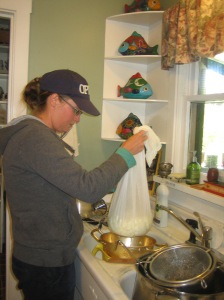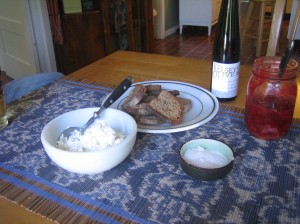Food is what led me to farming and working with livestock. I love so many aspects of food; eating, preparing, growing, gleaning, discussing and sharing. And while growing vegetables, picking fruit and baking bread have brought me closer to my food sources, there is a significant part of my diet that I had never experienced bringing from the field to the table- that is meat. This weekend Matt and I were offered the opportunity to assist Dan and his family in the slaughter and dressing of chickens they raised specifically for this purpose. Matt and I decided this would be a valuable opportunity to learn exactly what is involved in bringing meat to our dinner plate. We have both written about our experience here, with my writing in purple and Matt's in blue.
Eating any kind of meat involves the death of a creature. Rather than leave this death to the cold calculations of a machine in a processing factory, Dan and his family have decided to participate directly in it and treat each animal with respect and dignity.
Processing chickens with Callie was interesting, inspiring and appetizing; I was excited and interested in learning. Much of the food I eat is fresh, local and organic. But the meat I get, even though it’s from the Natural Foods Co-op in Sacramento, is pretty far removed from its natural state. It’s true that by the time the meat gets to my table I’ve little idea where it came from, who or what touched it. I feel like for someone who cares about food so much I’m missing out.
My excitement came from a place of curiosity – an opportunity to be directly involved in the food chain, as it were. Plus, I really trust Dan, who is a great teacher, so I knew the animals would be handled humanely and with dignity. My excitement nearly died as soon as we started. Perhaps the feeling didn’t die as much as it morphed into nervousness. I was still excited, but no longer was it a happy, curious interest, but more of an uneasy slightly sick feeling accompanied by a strong desire to learn.
We picked up the chickens and carried them from the coop to an open area where we could begin processing them. Their feet were leathery, warm and softer than I’d expected. The chickens squawked and flapped at first, then quickly became docile. This is when I began questioning my willingness to kill the chickens. In the back of my mind I knew it was something I wanted to learn and I was almost sure I was going to follow through with processing at least one chicken from start to finish. However, there was a part of me that thought of becoming a vegetarian. I thought of other animals that eat meat and how much I relate to many of them. Then I thought this process of catching, killing and cleaning the animals was necessary unless I was going to eat these chickens alive. With this fresh wave of insight, I was again glad to be part of the process.
Once we brought all 15 chickens out we watched Dan slaughter the first one. I was physically ready to go through with the lesson, alert and focused. Emotionally I was still struggling a little bit; I couldn’t help but to empathize with the chickens. The tone had turned solemn and serious. Earlier in the day at the Farmers’ Market in Auburn there was an opportunity to joke around, be friendly and loose. This, however, wasn’t a time for joking around; it was a time to be respectful and everyone seemed to pick up on that.
Slaughtering a chicken involves using a sticking knife to pierce the jugular vein and letting the chicken bleed out. Letting them bleed out is important for the feather plucking, evisceration and cleaning that follows. For many reasons this is the most humane way to process chickens. I also learned that in large operations where machines are used, the inside of the chicken can get all over the outside and therefore it must go through a bleach bath before it is fit for consumption. Those large mechanized farms are hardly capable of respecting the life of animals or of handling the product in a dignified way.
After Dan used his experienced hands to slaughter the third chicken, the first had bled out and was ready for plucking. We used a chicken plucker, which speeds up the process and does a clean job. The machine does the plucking but requires a knowledgeable person to hold and guide the bird so most of the feathers can be removed. I still retain the idea that hand-plucking is a bit more dignified for the spirit of the animal because they do look a little silly on the plucker. It was the only time that I felt the slight urge to laugh, a sign that my often-strange sense humor hadn’t left me.
Then it was time to be serious again. Dan knew I was interested in learning the full process. He asked me if I wanted to dispatch one of the birds and reassured me that I didn’t have to. I wanted to and I did. I was determined to learn and it was a good thing. The way Dan showed me how to use the sticking knife was to bypass the windpipe and esophagus and strike through the jugular vein. The first bird I cut through the neck, and there was no blood meaning I had done it wrong. It wasn’t like many mistakes where you can erase it and try again. I held the bird’s head and tried again. I missed two more times, and gave the knife to Dan who quickly finished it off. The next bird I did better; I did it wrong at first, but was able to finish it off myself and learned exactly what I was doing wrong. The third bird I did perfectly on my first try. I remember exactly what I did differently and am glad I was capable of doing so.
As I stood there with the animals I had killed, letting them bleed out, I felt a special bond. It was strange how by killing this animal I gained a respect for it and for all life. I authentically accepted a natural order and gained an appreciation for all life. I looked into the sky and felt a gentle, yet intense connection to a great, giant spirit. I thought of the life of grass and grain. I thought of that life passing into the bodies of the chickens and sheep. I thought of that energy going into me. I thought of using that energy to learn and build. Then I felt a reassurance that all that energy and life would one day leave me to join that Great Spirit, as well as feed the grass and grain in the soil.
I’m so glad I learned how to process a chicken in this way; tt is a skill I hope to use to help feed my family and friends in the future.
While I couldn't bring myself to slaughter a chicken, I did help Dan's wife, Sami, in the dressing and prepping of the birds for storage. As each plucked bird was brought to us we would remove the heads and feet. Then the innards were skillfully separated from the carcass (a skill I was slow to learn, thank your for your patience Sami!) The birds were chilled in ice water, weighed and packaged for freezing. By the time we were through they looked just like what you can buy at the supermarket, only we knew their whole history; what they ate, what conditions they lived in, how they were treated and how they died. This is information you just cannot buy.
While eating meat has been morally confusing to me at times, having this experience is invaluable to me. I have made the decision to eat meat, I feel the least I can do is know what is involved in turning a living being into "meat". I would also like to give a heartfelt thank-you to Dan, Sami and their daughters for allowing us to learn from them; you are thoughtful and patient teachers and are a valuable asset to our community.



















